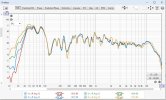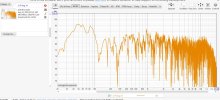Thanks for uploading your .mdat files. I had a look.
View attachment 386607
These are your floorstanding speakers (red) and subwoofer (green) with 1/12 smoothing applied. ASSUMING that both measurements were taken properly and the mic was not moved, we can see:
- the subwoofer is massively down in gain compared to the main speakers. About 25dB down. They are contributing very little to the sound, mostly <40Hz. You did not indicate what gain setting you had on the sub when the green curve was measured, but my prediction is gain +6.
- the mains produce too much bass down to 40Hz, and then it drops off a cliff. About 10dB too much bass.
- the dip at 130Hz is likely due to improper positioning of the mains. It is going to be either SBIR or a room mode.
View attachment 386609
This is a comparison of mains only (red) and mains with sub on +9 gain (yellow). You can see that the two curves hug each other perfectly above 100Hz. Below 100Hz, the start to deviate. the amount of deviation from the red is what your subwoofer is contributing. So you can see ... 1dB here and there, but where it really kicks in is <40Hz where it fills in the missing bass adequately. Not as much as we would like, but at least it is doing something.
Diagnosis: main speakers are producing 10dB too much bass between 40Hz - 100Hz.
Comments:
- It does not look like you can high pass your mains above 100Hz because your subs don't go high enough, nor are they loud enough to take over bass duties if the mains are high passed. So the usual suggestion of "high pass your mains, low pass your subs" does not look feasible IMO. It is still possible, but most of the improvement can be made by EQ. So your best bet is to use EQ to cut down your mains by 10dB <100Hz. Then use your subs with gain +9. Remeasure after you do this.
There is more to see. You have a broad dip centred around 125Hz. This is what "Mains + gain 9" looks like with ERB smoothing:
View attachment 386616
ERB smoothing tries to replicate what you will actually hear. We can see that you have a huge suckout in your midbass between 120Hz to 360Hz ... it is 240Hz wide, and up to 10dB deep, about 5dB deep on average. Midbass is where punch and impact can be found. If you have a curve like that, with too much bass and missing midbass, it will sound a bit bloated and bassy but somehow lacking punch. But it does not tell us what the culprit is.
View attachment 386620
For that, we look at the same curve, but this time with 1/12 Gaussian smoothing. We can see that the culprits are two huge dips, around 125Hz, and another at 270Hz.
If we focus on the dip at 125Hz only, you will see that it is 40Hz wide, and 10dB deep. It's actually comprised of two dips merged into one - 121Hz and 129Hz.
You said your speakers are 2ft from the side wall, and 1.5ft from the front wall - this means the SBIR wavelengths are going to be 8ft and 6ft respectively - 140Hz and 190Hz. If this is due to SBIR, then it is possible that your front wall and side wall distances are closer together than you indicated. One rule is to avoid placing speakers equidistant from the front wall and side wall, because the SBIR cancellation sums and you get a dip which is twice as deep. Get a tape measure out and check the distances again. One of the distances is going to be 2.35ft, and the other is probably 2.2ft (depending on the speed of sound where you live) IF it is SBIR. Read more about SBIR
here.
The other possibility is a room mode. The 270Hz dip is in the transition zone, also likely a room mode. The solution would be: move your speakers and listening position around a little bit and see if it improves. You can use REW's room simulator and see what happens.












